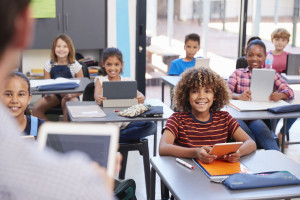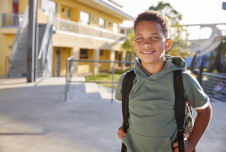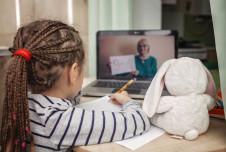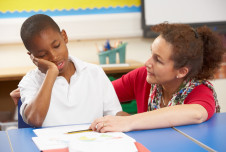Effective teachers cultivate positive relationships with students every day, no matter if the classroom is physical or virtual. They foster emotional connections among students, and help them to feel a sense of belonging and purpose.

This is not a small task. In fact, it is possibly one of the most difficult but important things an educator can do. According to the latest research in developmental science, relationships between and among children and adults are “a primary process through which biological and contextual factors influence and mutually reinforce each other.”
This means that when children experience positive relationships, they are not only creating the pathways for lifelong learning, adaptation, and integration of social, emotional, and cognitive skills, but also making qualitative changes to their genetic makeup. In other words, children’s brains change in response to their life experiences, relationships, and the environments they encounter from birth into adulthood.
Positive relationships also foster resilience, and reduce the impact that negative factors—such as adverse childhood experiences (ACE)—may have on children’s healthy development. Researchers from the Center on the Developing Child at Harvard University suggest that these positive experiences, along with support from adults and the development of adaptive skills, can counterbalance the lifelong consequences of adversity.
Unfortunately, differences in social and cultural backgrounds can make it harder for students to trust teachers. For instance, Black, Indigenous, and People of Color (BIPOC) students and their families may have a hard time trusting their white teachers, given America’s history and current reality of institutionalized racism. At the same time, white teachers may not be inclined to trust their BIPOC students due to their own bias and learned beliefs. This trust gap may hinder their ability to establish meaningful relationships, and can affect students’ academic success.
While an increasing number of schools are adopting social-emotional learning (SEL) programs and practices to create positive learning environments, many fail to incorporate cultural competence as an essential building block to foster these trusting relationships. However, educators still need to gain awareness of their own cultural identity, consider their biases, and how they use their power and privilege with students. Cultural competence also means that educators develop their ability to learn about and build on the varying cultural and community assets of students and their families.
In my new book, Teaching with the HEART in Mind: A Complete Educator’s Guide to Social Emotional Learning, I discuss why educators need to build their cultural competence in order to nurture positive relationships—and how they can ensure that students feel respected, seen, and affirmed. At the root of developing a culturally responsive classroom lies the belief that students’ diverse cultural practices and ethnic backgrounds are assets in the learning process, that should be celebrated and incorporated into academic content and pedagogy. “Culture is central to student learning,” writes education consultant Zaretta Hammond. “Cultural practices shape students’ thinking processes, which serve as tools for learning in and outside of school.” Therefore, students’ languages, cultures, and life experiences should be acknowledged as meaningful sources for learning and understanding.
Considering that almost 80% of teachers in public schools are white, while almost half of public elementary and secondary school students are people of color, it is essential that educators create a space where students can bring the pride they feel for their race and ethnicity, and develop an appreciation for diverse racial and ethnic identities. This will support BIPOC students to succeed in school as individuals—and it can help plant the seeds for a more equitable and just world. Here are five strategies for developing cultural competence in the classroom, adapted from my book.
1. Develop an awareness of your own racial and cultural identity
This entails identifying the historical roots of your identity, as well as beliefs, values, the way culture has influenced your life, and the things that motivate and matter to you. It also involves considering implicit biases, and the privileges and disadvantages afforded to you based on your race or ethnicity. This process is especially important for white educators, since research suggests people of color will commonly begin developing their racial identity before white people. According to author and University of Georgia professor Dr. Anneliese Singh, developing a positive racial identity entails cultivating nonjudgmental curiosity—questioning old ideas and remaining open to new ones.
Once educators engage in this process of developing their racial and cultural identity, they can consider their internalized perceptions toward other racial and ethnic groups and decide to challenge or maintain these perceptions. As educators intentionally engage in developing their own racial identity, they will be better equipped to support students in doing the same.
2. Learn about each student and incorporate this knowledge into classroom instruction
The quality of teacher-student relationships has been repeatedly linked with students’ academic, social, and emotional outcomes. These relationships can be established when educators take the time to know their students individually; learning about students’ historical roots, ethnic group, home language, religion, or immigration story can provide teachers with valuable information. Even if students identify with a single racial or ethnic group, educators shouldn’t make assumptions about their values or beliefs, since there is great variability within communities. Getting to know students individually, while learning about the history and culture of their identities, sets up the foundation to establish meaningful relationships with students.
Once educators have learned about the varying racial and cultural assets of students, they can try to connect academic instruction with students’ prior knowledge and experiences. Teachers can spark students’ motivation for learning by contextualizing the content and making it relevant to students’ lives. When students are able to bring what they already know into their classrooms, deeper connections can be made with new academic content.
3. Promote an inclusive and equitable classroom that proactively works to counter bias
In order for classrooms to be inclusive and equitable, educators need to understand the larger sociopolitical context that shapes individual experiences. Many BIPOC, LGTBQ+, or neurodiverse students, and those coming from low-income backgrounds, experience insults and denigrating messages in and outside of school on a regular basis. When students have to face hostile environments, they use most of their cognitive and emotional skills for dealing with these challenges rather than for learning.
When safe and supportive environments are created, and students’ unique traits and life experiences are acknowledged, celebrated, and used to enrich the learning environment, students are more likely to feel a sense of belonging and be able to engage with the classroom content in meaningful ways.
This takes work. It requires a commitment to proactively dismantle racism and discrimination, and intentionally work to counteract and reverse implicit bias.
4. Get to know students’ families and invite them to the classroom
Parents also experience emotions about their children’s school and teachers. They may fear their child is being mistreated or bullied, or they may distrust a teacher whose culture is not the same as theirs. They may question a teacher’s suitability because the classroom doesn’t look like the classroom they attended when they were kids. Whatever their feelings toward teachers or the school, educators should remember that parents’ emotions are real and valid. They may not agree with them, but understanding these feelings will help educators to connect with these families.
 This essay is adapted from Teaching with the HEART in Mind: A Complete Educator’s Guide to Social Emotional Learning (Brisca Publishing, 2021, 254 pages).
This essay is adapted from Teaching with the HEART in Mind: A Complete Educator’s Guide to Social Emotional Learning (Brisca Publishing, 2021, 254 pages).
Educators can invite parents to participate in virtual or physical classrooms. This can take the shape of a family potluck, a getting-to-know-you back-to-school night, home visits, or phone calls to celebrate students’ accomplishments. The goal of these interactions is for educators to develop important connections with families: to learn about their beliefs, hopes, and dreams and to learn how they perceive their role in supporting their children’s education.
Elena Aguilar, author and founder of Bright Morning Consulting, encourages teachers to let families know that they want to learn about their individual cultures, acknowledging the differences that exist. Many immigrant parents worry that their home culture will be forgotten when kids go to school. For parents, it can be a big relief knowing that their child’s teacher wants to learn about their culture. Inviting parents into the classroom is also a great way to celebrate and share students’ cultures.
5. Learn about the community
This is an extension of knowing students and their families. Walking around a neighborhood and understanding the community’s assets—the food, music, traditions, or history of the neighborhood—as well as some of the issues they face can provide educators with important data to connect with students and inform teaching practices.
- How does the community celebrate special holidays?
- How has the neighborhood changed in the last decade?
- Are some of the parents facing unemployment or housing challenges?
- How is that affecting the student population that the school serves?
Educators can approach this process with curiosity and without judgment, searching for insights that can help them better serve students. As educators engage in this process, their immediate reactions to the neighborhood can provide valuable data to examine and counter their own biases. If educators notice they only see the deficits in the community, while having a difficult time seeing the assets, that can be an indicator that additional exploration and reflection is needed. As Hammond says, “You need to put yourself in a place where you are not the majority.”
Teachers can shape children’s growth and development in constructive ways through the power of relationships. They can make a positive impact in a child’s life by first developing their cultural competence and considering their learned beliefs and implicit biases, and then by recognizing the assets and greatness in their students and families, with the ultimate goal of creating emotional bonds, celebrating a sense of shared humanity, and nurturing trusting and meaningful relationships.







Comments